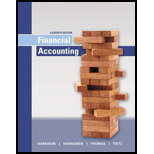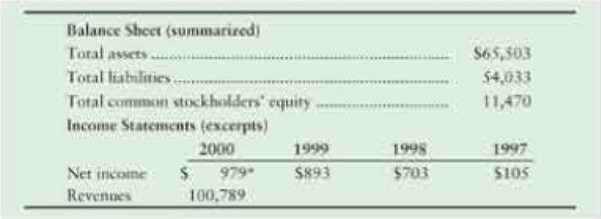
(Learning Objective 5: Explore an actual bankruptcy; calculate leverage ratio, ROA, debt ratio, and times-Interest-earned ratio) In 2002, Enron Corporation filed for Chapter 11 Q bankruptcy protection, shocking the business community: How could a company so large and successful go bankrupt? This case explores the causes and the effects of Enron's bankruptcy.
At December 31, 2000, and for the four years ended on that date. Enron reported the following (amounts in millions):

Unknown to Investors and lenders, Enron also controlled hundreds of
During the four-year period up to December 31, 2000, Enron’s stock price shot up from $17.50 to $90.56. Enron used its escalating stock price to finance the purchase of the SPEs by guaranteeing lenders that Enron would give them Enron stock if the SPEs could not pay their loans.
In 2001, the SEC launched an Investigation into Enron's accounting practices. It was alleged that Enron should have been including the SPEs In its financial statements all along. Enron then restated net income for the years up to 2000, wiping out nearly $600 million of total net income (and total assets) for this four-year period. Assume that $300 million of this loss applied to 2000. Enron's stock price tumbled, and the guarantees to the SPEs' lenders added millions to Enron's liabilities (assume the full amount of the SPEs' debt was included). To make matters worse, the assets of the SPEs lost much of their value; assume that their market value is only $500 million.
Requirements
1. Compute the debt ratio that Enron reported at the end of 2000. By using the DuPont Model, compute Enron's return on total assets (ROA) for 2000. For this purpose, use only total assets at the end of 2000, rather than the average of 1999 and 2000.
2. Compute Enron's leverage ratio for 2000. Use total assets and total
3. Add the asset and liability information about the SPEs to the reported amounts provided in the table. Recompute all ratios after including the SPEs in Enron's financial statements. Also compute Enron's times-interest-earned ratio both ways for 2000. Assume that the changes to Enron's financial position occurred during 2000.
4. Why does it appear that Enron failed to include the SPEs in its financial statements? How do you view Enron after including the SPEs in the company's financial statements? (Challenge)
Want to see the full answer?
Check out a sample textbook solution
Chapter 9 Solutions
Financial Accounting (11th Edition)
- FGH Floral Company has a delivery truck that is being sold after 5 years of use. The current book value of the delivery truck is $6,000. If FGH Floral Company sells the delivery truck for $9,000, what is the impact of this transaction? Answerarrow_forwardFinancial Accounting Question please solvearrow_forwardY Company purchased an asset for $73,000 on January 1, Year 1. The asset was expected to have a four-year life and an $8,000 salvage value. What would be the amount of depreciation expense for Year 1 using double-declining balance? Answerarrow_forward
- Y Company purchased an asset for $73,000 on January 1, Year 1. The asset was expected to have a four-year life and an $8,000 salvage value. What would be the amount of depreciation expense for Year 1 using double-declining balance? Ansarrow_forwardFinancial Accountingarrow_forwardSnowbird Company is constructing a building that qualifies for interest capitalization. It is built between January 1 and December 31, Year 1. Snowbird made the following expenditures related to this building: April 1 $396,000July 1 400,000September 1 510,000December 1 120,000The company borrowed $500,000 at 12% to help finance the project. In addition, Snowbird had outstanding borrowings of $2 million at 8% and $1 million at 9%. Required: Compute the amount of interest capitalized related to the construction of the building. Next Level What effect does the interest capitalization have on the company’s financial statements after it completes the building?arrow_forward
- FGH Floral Company has a delivery truck that is being sold after 5 years of use. The current book value of the delivery truck is $6,000. If FGH Floral Company sells the delivery truck for $9,000, what is the impact of this transaction? Provide Answerarrow_forwardOn August 1, 20Y7, Rafael Masey established Planet Realty, which completed the following transactions during the month: Rafael Masey transferred cash from a personal bank account to an account to be used for the business in exchange for Common Stock, $22,000. Purchased supplies on account, $1,190. Earned sales commissions, receiving cash, $18,260. Paid rent on office and equipment for the month, $4,020. Paid creditor on account, $440. Paid dividends, $1,080. Paid automobile expenses (including rental charge) for month, $1,110, and miscellaneous expenses, $750. Paid office salaries, $2,340. Determined that the cost of supplies used was $660.arrow_forwardWhat is the corporation's tax liability on these financial accounting question?arrow_forward

 Financial Reporting, Financial Statement Analysis...FinanceISBN:9781285190907Author:James M. Wahlen, Stephen P. Baginski, Mark BradshawPublisher:Cengage Learning
Financial Reporting, Financial Statement Analysis...FinanceISBN:9781285190907Author:James M. Wahlen, Stephen P. Baginski, Mark BradshawPublisher:Cengage Learning EBK CONTEMPORARY FINANCIAL MANAGEMENTFinanceISBN:9781337514835Author:MOYERPublisher:CENGAGE LEARNING - CONSIGNMENT
EBK CONTEMPORARY FINANCIAL MANAGEMENTFinanceISBN:9781337514835Author:MOYERPublisher:CENGAGE LEARNING - CONSIGNMENT



